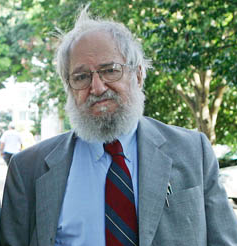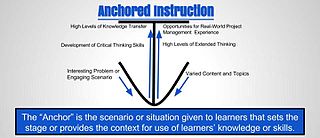Related Research Articles
An instructional theory is "a theory that offers explicit guidance on how to better help people learn and develop." It provides insights about what is likely to happen and why with respect to different kinds of teaching and learning activities while helping indicate approaches for their evaluation. Instructional designers focus on how to best structure material and instructional behavior to facilitate learning.

Learning theory describes how students receive, process, and retain knowledge during learning. Cognitive, emotional, and environmental influences, as well as prior experience, all play a part in how understanding, or a worldview, is acquired or changed and knowledge and skills retained.
Robert Mills Gagné was an American educational psychologist best known for his Conditions of Learning. He instructed during World War II when he worked with the Army Air Corps training pilots. He went on to develop a series of studies and works that simplified and explained what he and others believed to be good instruction. Gagné was also involved in applying concepts of instructional theory to the design of computer-based training and multimedia-based learning. His work is sometimes summarized as the Gagné assumption: that different types of learning exist, and that different instructional conditions are most likely to bring about these different types of learning.
Instructional design (ID), also known as instructional systems design and originally known as instructional systems development (ISD), is the practice of systematically designing, developing and delivering instructional materials and experiences, both digital and physical, in a consistent and reliable fashion toward an efficient, effective, appealing, engaging and inspiring acquisition of knowledge. The process consists broadly of determining the state and needs of the learner, defining the end goal of instruction, and creating some "intervention" to assist in the transition. The outcome of this instruction may be directly observable and scientifically measured or completely hidden and assumed. There are many instructional design models, but many are based on the ADDIE model with the five phases: analysis, design, development, implementation, and evaluation.
Computer science is the study of the theoretical foundations of information and computation and their implementation and application in computer systems. One well known subject classification system for computer science is the ACM Computing Classification System devised by the Association for Computing Machinery.
Software design is the process of conceptualizing how a software system will work before it is implemented or modified. Software design also refers to the direct result of the design process – the concepts of how the software will work which consists of both design documentation and undocumented concepts.
Instructional scaffolding is the support given to a student by an instructor throughout the learning process. This support is specifically tailored to each student; this instructional approach allows students to experience student-centered learning, which tends to facilitate more efficient learning than teacher-centered learning. This learning process promotes a deeper level of learning than many other common teaching strategies.
In psychology, cognitivism is a theoretical framework for understanding the mind that gained credence in the 1950s. The movement was a response to behaviorism, which cognitivists said neglected to explain cognition. Cognitive psychology derived its name from the Latin cognoscere, referring to knowing and information, thus cognitive psychology is an information-processing psychology derived in part from earlier traditions of the investigation of thought and problem solving.
A cognitive tutor is a particular kind of intelligent tutoring system that utilizes a cognitive model to provide feedback to students as they are working through problems. This feedback will immediately inform students of the correctness, or incorrectness, of their actions in the tutor interface; however, cognitive tutors also have the ability to provide context-sensitive hints and instruction to guide students towards reasonable next steps.
Situated cognition is a theory that posits that knowing is inseparable from doing by arguing that all knowledge is situated in activity bound to social, cultural and physical contexts.

Constructivism in education is a theory that suggests that learners do not passively acquire knowledge through direct instruction. Instead, they construct their understanding through experiences and social interaction, integrating new information with their existing knowledge. This theory originates from Swiss developmental psychologist Jean Piaget's theory of cognitive development.
In cognitive psychology, cognitive load refers to the amount of working memory resources used. However, it is essential to distinguish it from the actual construct of Cognitive Load (CL) or Mental Workload (MWL), which is studied widely in many disciplines. According to work conducted in the field of instructional design and pedagogy, broadly, there are three types of cognitive load: intrinsic cognitive load is the effort associated with a specific topic; extraneous cognitive load refers to the way information or tasks are presented to a learner; and germane cognitive load refers to the work put into creating a permanent store of knowledge. However, over the years, the additivity of these types of cognitive load has been investigated and questioned. Now it is believed that they circularly influence each other.

Constructionist learning is the creation by learners of mental models to understand the world around them. Constructionism advocates student-centered, discovery learning where students use what they already know to acquire more knowledge. Students learn through participation in project-based learning where they make connections between different ideas and areas of knowledge facilitated by the teacher through coaching rather than using lectures or step-by-step guidance. Further, constructionism holds that learning can happen most effectively when people are active in making tangible objects in the real world. In this sense, constructionism is connected with experiential learning and builds on Jean Piaget's epistemological theory of constructivism.
An intelligent tutoring system (ITS) is a computer system that imitates human tutors and aims to provide immediate and customized instruction or feedback to learners, usually without requiring intervention from a human teacher. ITSs have the common goal of enabling learning in a meaningful and effective manner by using a variety of computing technologies. There are many examples of ITSs being used in both formal education and professional settings in which they have demonstrated their capabilities and limitations. There is a close relationship between intelligent tutoring, cognitive learning theories and design; and there is ongoing research to improve the effectiveness of ITS. An ITS typically aims to replicate the demonstrated benefits of one-to-one, personalized tutoring, in contexts where students would otherwise have access to one-to-many instruction from a single teacher, or no teacher at all. ITSs are often designed with the goal of providing access to high quality education to each and every student.

The following outline is provided as an overview of and topical guide to thought (thinking):
Adaptive expertise is a broad construct that encompasses a range of cognitive, motivational, and personality-related components, as well as habits of mind and dispositions. Generally, problem-solvers demonstrate adaptive expertise when they are able to efficiently solve previously encountered tasks and generate new procedures for new tasks. This definition can be contrasted with more traditional ideas of expertise popularized by Chi and others, which do not typically consider adaptation to completely novel situations. Its empirical validity has been examined in a number of training and learning contexts. The term was first coined by Giyoo Hatano and Kayoko Inagaki, to tease out the variability within groups of experts. Hatano and Inagaki, described two types of expertise: routine expertise, or classic expertise, and adaptive expertise. They defined routine expertise as involving mastering procedures in such a way as to become highly efficient and accurate, whereas developing adaptive expertise requires an individual to develop conceptual understanding that allows the "expert" to invent new solutions to problems and even new procedures for solving problems. To illustrate, imagine two sushi chefs: one who makes every piece perfectly but routinely makes the same few types over and over, and one produces new menus frequently. To some, this is an unfair comparison, as ones' environment supports behavior. For example, the routine of the classic expert sushi chef may be tied to his restaurant environment, and this chef may be able to break out of the routines easily given a different situation. However, the adaptive expert chef clearly demonstrates flexible knowledge and performance of sushi-making. Learning Scientists are interested in adaptive expertise, in part because they would like to understand the types of learning trajectories that may allow practitioners break free from routines when necessary.
The worked-example effect is a learning effect predicted by cognitive load theory. Specifically, it refers to improved learning observed when worked examples are used as part of instruction, compared to other instructional techniques such as problem-solving and discovery learning. According to Sweller: "The worked example effect is the best known and most widely studied of the cognitive load effects".
An instructional simulation, also called an educational simulation, is a simulation of some type of reality but which also includes instructional elements that help a learner explore, navigate or obtain more information about that system or environment that cannot generally be acquired from mere experimentation. Instructional simulations are typically goal oriented and focus learners on specific facts, concepts, or applications of the system or environment. Today, most universities make lifelong learning possible by offering a virtual learning environment (VLE). Not only can users access learning at different times in their lives, but they can also immerse themselves in learning without physically moving to a learning facility, or interact face to face with an instructor in real time. Such VLEs vary widely in interactivity and scope. For example, there are virtual classes, virtual labs, virtual programs, virtual library, virtual training, etc. Researchers have classified VLE in 4 types:
Andrew S. Gibbons is an American practitioner and theorist in the field of instructional design and technology. He has proposed an architectural theory of instructional design influenced by the structural principles of artifact modularization drawn from a number of design disciplines, as exemplified by the work of Carliss Baldwin and Kim B. Clark.

Anchored Instruction is a technology centered learning approach, which falls under the social constructionism paradigm. It is a form of situated learning that emphasizes problem-solving within an integrated learning context, which can be examined from multiple perspectives. "In other words, the learning is contextualized to provide students with realistic roles that serve to enhance the learning process",. During teaching, activities are designed or tied around an "anchor", such as an adventure or story, with a problem at the end, that needs to be resolved. The connection made between the content and the authentic context is referred to as "anchoring". These models typically embed all the information needed for the problem to be solved, such data and hints. Anchored instruction is akin to problem-based learning (P.B.L.) with the exception of its open-endedness.